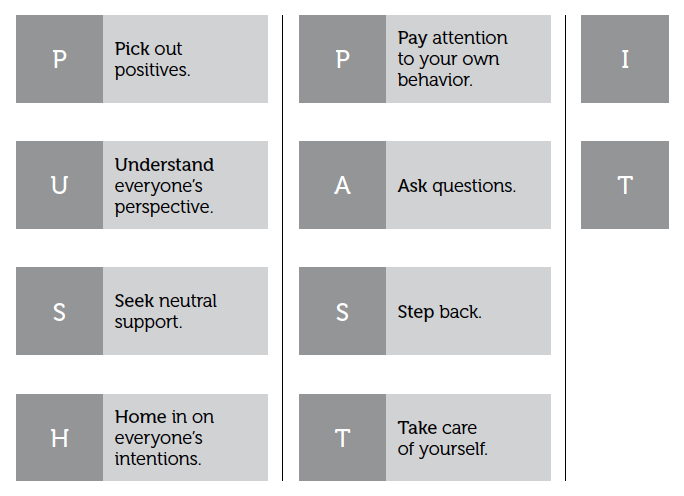Cooling Down Strategy for Teachers: Pushing Past It
August 18th, 2021 | 4 min. read

In those moments when you face challenging behaviors in the classroom, pushing yourself is crucial. But what exactly does push yourself mean? It is more than simply forcing yourself to be logical when your emotions want full control, though that is an important element. Angela Searcy, author of Push Past It! A Positive Approach to Challenging Classroom Behaviors, says that this is where the PUSH PAST It technique comes in. PUSH PAST It is an acronym for a cognitive process that moves your brain from your initial reaction to a higher level of thinking so you can problem solve.
Keep in mind that PUSH PAST It is not a one-and-done activity! It is a method that you must practice and repeat until it becomes an integrated thought process that you can quickly engage when you encounter challenging behaviors.

1. Think of a child, family member, or coworker with challenging behaviors. Using the PUSH PAST IT Handout at the bottom of this page, write down your negative feelings about that person or those people at the bottom of the handout.
2. Go through the process of PUSH PAST It by writing down your applicable thoughts for each letter on the handout
- Pick out positives: Write at least one positive thing about the child, family member, or coworker.
- Understand everyone’s perspective: Describe the situation from the perspective of the child, family member, or coworker. Be honest with yourself about how the other party probably feels.
- Seek neutral support: List the people you have talked to about this situation. Consider whether they are truly neutral or whether they simply echo your own thoughts. If they are not neutral, list some other people who might be more helpful to talk to.
- Home in on everyone’s intentions: Based on what you wrote down for U, write what you think the child, family member, or coworker is trying to accomplish with the challenging behavior. Is the child really out to ruin your day, or is he desperately trying to express a need? Is the family member genuinely trying to harm the child, or do you actually agree with the family member’s intentions but not his actions? Is your coworker intentionally being difficult, or is he having a hard time in his personal life? Have you asked any of these people lately how they are doing?
- Pay attention to your own behavior: List your physical and emotional reactions to the challenging behavior.
- Ask questions: Educators should always respond to challenging behavior with curiosity. Brainstorm questions that could help you find the reason or reasons behind the challenging behavior. Is the child getting nutritious food, adequate sleep, and proper hygiene? Could a family member be upset at a situation rather than at you or be uncooperative because of a bad previous experience with school? Is he taking out unrelated frustrations on you or dealing with difficult life events? Is your coworker stressed out?
- Step back: Pause. Take time to really look at this situation and think deeply about it. Write down any insights that come to you.
- Take care of yourself: List all the ways that you are taking care of your own mental health.
3. Now look again at the thoughts you wrote at the bottom of the page. Apply logic to those negative statements and rephrase them into positive thoughts, ideas, or questions that can help you work with the child, family member, or coworker. Write the new versions at the top of the page. Here’s an example of how a filled-out handout might look:
- Negative feelings: “Jorge is driving me crazy! Every day, I have to deal with him grabbing toys from other children. His parents never answer the phone or return my calls. They’re just too lazy to teach him to say please and thank you and use other basic manners.”
- Pick out positives: “Jorge has a nice smile. His parents bring him to school, so they must value education.”
- Understand everyone’s perspective: “Jorge is likely feeling confused or scared because he’s new to our school. His family just moved and both parents have new jobs, so they’re probably overwhelmed.”
- Seek neutral support: “My coteacher listens and gives me encouragement, but Jorge is driving him crazy too. Maybe I should talk to my director for some neutral ideas.”
- Home in on everyone’s intentions: “Is Jorge just being selfish when he grabs toys from others, or is he trying to communicate something that he can’t yet verbalize? Do his parents really not care whether he has good manners, or do we just not agree on what good manners are or when children should learn them?”
- Pay attention to your own behavior: “When Jorge grabs toys from other children, my heart beats fast, and I feel anxious.”
- Ask questions: “What could be going on in Jorge’s life and in his parents’ lives to make them act this way? Is Jorge upset because he had to leave a familiar school? Are his parents ignoring my calls because they feel too busy to deal with one more situation?”
- Step back: “Now that I think about it, Jorge’s sleep schedule might be out of whack because he’s not used to his new bedroom yet.”
- Take care of yourself: “As much as I can, I do my lesson planning at school so I don’t have to think about it at home. I go for a walk every day after dinner. I make plans with friends each weekend so I have something to look forward to.”
When you rephrase your original negative thoughts in the balloons at the top of the handout, they might look something like this:
- “Jorge is driving me crazy!”
> “This is a tough situation, but I want what’s best for Jorge.”
- “Every day, I have to deal with him grabbing toys from other children.”
>“He’s only three. He doesn’t know how to share yet.”
- “His parents never answer the phone or return my calls.”
>“I’ll keep trying and figure out how to effectively communicate with this family.”
- “They’re just too lazy to teach him to say please and thank you and use other basic manners.”
>“I wonder what this family’s home life is like.”
Author(s)Angela Searcy, EdD
Lisa Williford, an experienced marketing event coordinator, served with Kaplan Early Learning Company and Gryphon House from 2020 - 2023.